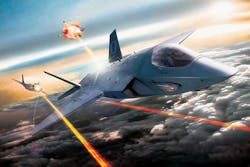DARPA researchers want small fiber laser diode for laser weapons in future combat aircraft
ARLINGTON, Va., 12 Jan. 2017. U.S. military researchers are asking for industry's help in developing compact, fiber laser diode modules suitable for pumping high power fiber laser weapons on a variety of manned and unmanned combat aircraft and tactical land vehicles.
Officials of the U.S. Defense Advanced Research Projects Agency (DARPA) in Arlington, Va., have released a solicitation (HR001117S0013) for the Efficient Ultra-Compact Laser Integrated Devices (EUCLID) project.
The idea is to reduce the size and weight of high-energy laser (HEL) technology, which until now has been too big and heavy for wide deployment on most tactical military aircraft, land vehicles, and small boats.
For these kinds of military platforms fiber laser arrays are leading candidates to provide capabilities like silent engagement, deep magazine, scalable effects, and reduced logistics burdens.
Fiber laser technology offers electrical-to-optical efficiencies of more than 35 percent, promising beam quality, and modular, scalable architectures with the potential for scalable laser output powers tailored to different missions and payloads.
It's true that electro-optics scientists have been able to reduce the size and weight of fiber amplifiers and related HEL technology sufficiently for integration on large military aircraft and trucks, yet DARPA researchers are looking for smaller sizes, lighter weights, and better efficiencies for use on platforms like manned fighter aircraft, unmanned aerial vehicles (UAVs), and fast maneuverable tactical combat vehicles.
Not only would enhancing the size, weight, and efficiencies of fiber laser diode modules lend themselves to laser weapons on tactical military systems, but it also could increase laser power on large platforms like the AC-130 gunship and Heavy Expanded Mobility Tactical Truck (HEMMIT).
More widespread deployment of these laser systems, furthermore, could stimulate larger market volume and lower unit costs, DARPA officials say.
The DARPA EUCLID project seeks to develop diode pump modules with at least 650 Watts of continuous-wave output power, and pump assembly values of at least 3,900 Watts, with at least 58 to 60 percent electrical to optical efficiencies.
The volume of these devices should be no larger tan 0.31 cubic centimeters per Watt for diode pump modules, and no larger than 0.5 cubic centimeters per Watt for pump assemblies. Diode pump modules should weigh no more than 0.31 grams per Watt, and pump assemblies should weigh no more than 0.43 grams per Watt.
Cooling should be consistent with that available on fighter aircraft like the F-15 Eagle or F-16 Fighting Falcon jet fighters, for example cooling fluids with minimal viscosity changes to temperatures as cold as -30 degrees Celsius.
These devices should last for more than 100 hours at full power, with no more than 5 percent power degradation, and should be capable of being densely packaged with other identical modules in line-replaceable high-power fiber amplifier assemblies.
Related: Lockheed Martin laser weapons work tackling the problem of atmospheric turbulence
The goal is to develop packaged pump assemblies with as many as six diode pump modules that include power supply and cooling. These pump assemblies should be able to support two 1.6-kilowatt coherently combinable fiber amplifiers or one 3.2-kilowatt coherently combinable fiber amplifier.
The two-year DARPA Euclid project will be worth about $6 million, and should involve one or more contractors. The project should select its contractors and start by sometime this July.
Companies interested should submit proposals no later than 15 Feb. 2017 to the DARPA BAA Website at https://baa.darpa.mil. Email questions or concerns to DARPA at [email protected].
More information is online at https://www.fbo.gov/spg/ODA/DARPA/CMO/HR001117S0013/listing.html.
Learn more: search the Aerospace & Defense Buyer's Guide for companies, new products, press releases, and videos

